Sometimes birds behave exactly opposite of how the literature says they’re “supposed” to behave. This is a possible example.
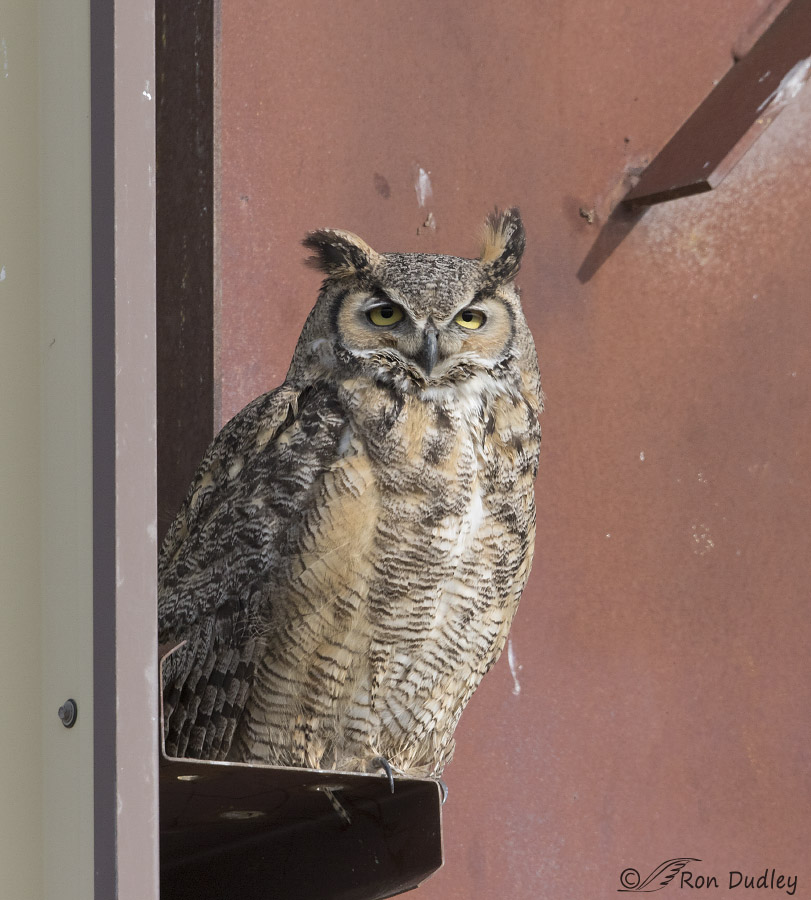
1/2500, f/6.3, ISO 800, Canon 7D Mark II, Canon EF500mm f/4L IS II USM, not baited, set up or called in
Many (perhaps most) local birders, nature lovers and bird photographers are aware of the resident Great Horned Owls in the “hay barn” on Antelope Island. They’ve been there for years. Usually during daytime they’re high on the interior metal girders and in the shade but earlier this week I found this adult basking in the morning sun on the exterior of the building. The bird was so sleepy that it usually had its eyes closed.
I rarely visit these birds because the setting and lighting leave a lot to be desired and I like to leave them in peace but occasionally when the gate to the area is open (which isn’t often lately) I take one turn around the barn just to check on their welfare.
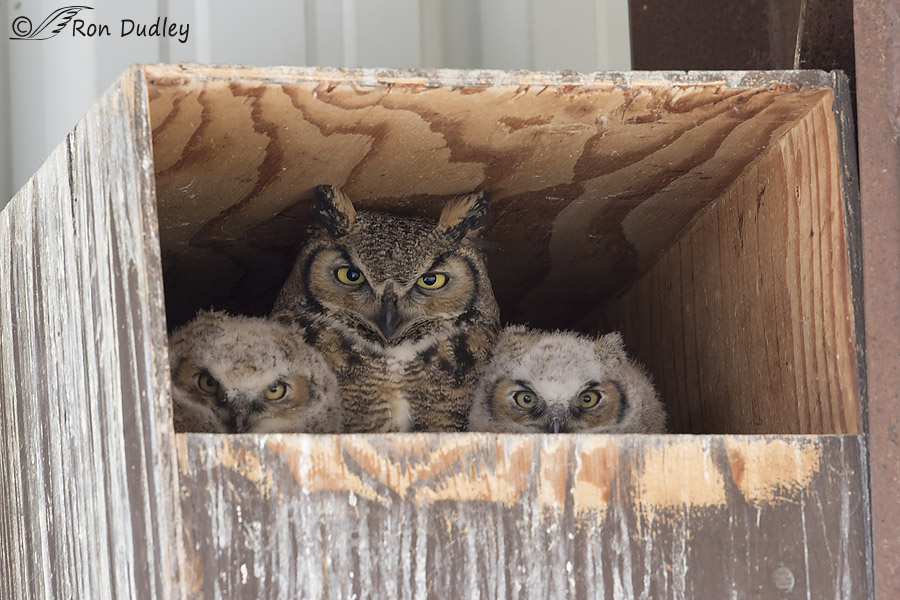
1/80, f/7.1, ISO 500, Canon 7D Mark II, Canon EF500mm f/4L IS II USM + 1.4 tc, not baited, set up or called in
Each year they raise a family in this nest box on one of the high girders. This year they’re raising two chicks – this is what they looked like three weeks ago (the image is a little soft at 1/80 sec).
But not too far away there’s another nest box under the roof of the same barn…
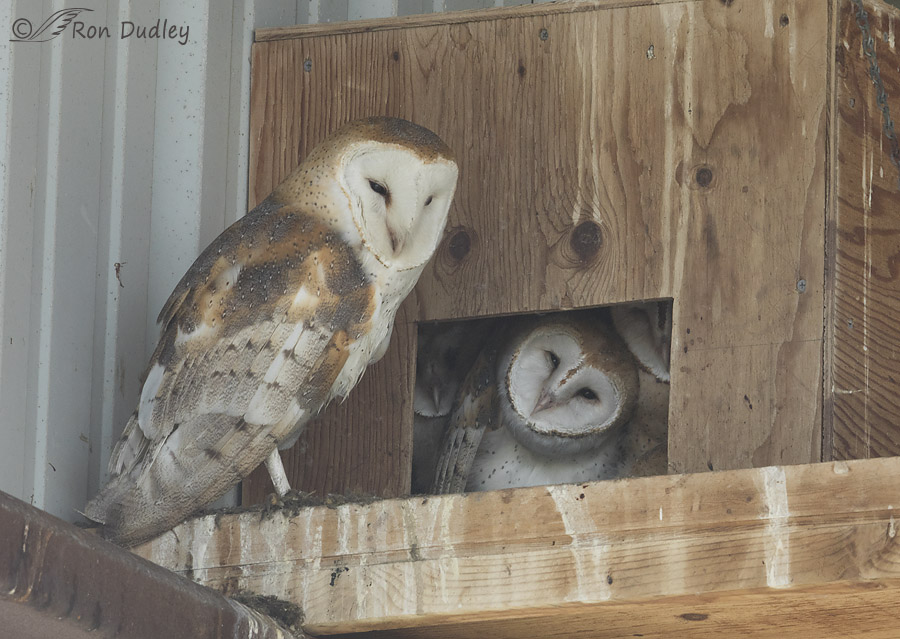
1/100, f/14, ISO 800, Canon 7D Mark II, Canon EF500mm f/4L IS II USM, not baited, set up or called in
that is occupied by Barn Owls and it has been for years. This image was taken the same day as the first shot of the Great Horned Owl so you can see that both species are raising families under the same roof simultaneously and they’ve been doing so for many seasons.
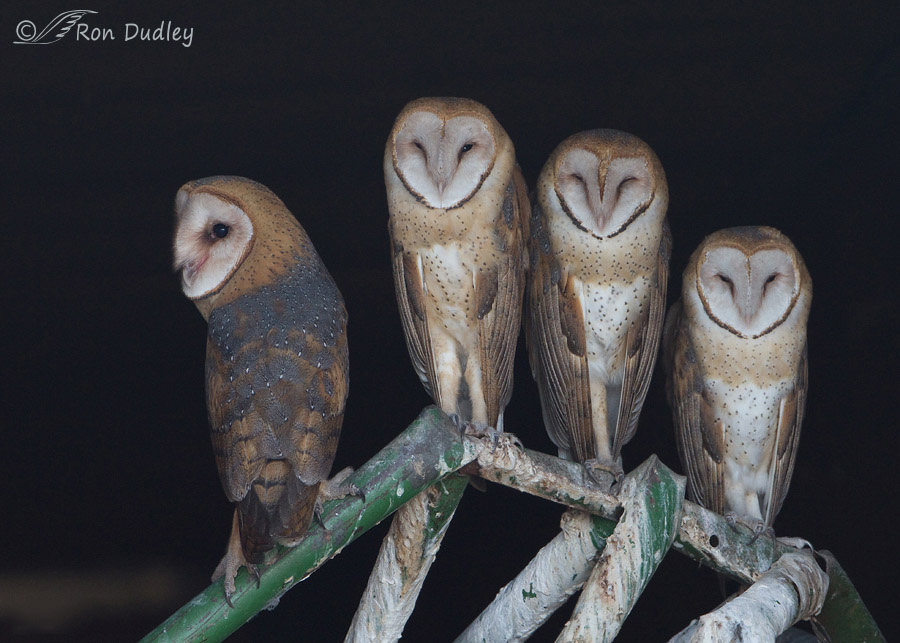
1/60, f/8, ISO 640, Canon 7D, Canon EF500mm f/4L IS USM, not baited, set up or called in
There used to be a dilapidated old metal trailer adjacent to the barn that was filled with an assortment of metal junk and once the Barn Owl chicks were fledged they would often roost deep in its interior during the daytime. There were five of them but here one can’t be seen. This image was taken five summers ago.
I’ve always wondered how these two species of owls coexist so compatibly under the same roof. It’s always been my understanding that owls in general and Great Horned Owls in particular do not tolerate the close presence of other resident owls but these birds apparently haven’t read the scientific literature on behavior.
One of my trusted sources for information on bird behavior is Birds of North America Online (a paid subscription site) out of Cornell University. Here’s some of what they have to say on the subject about Great Horned Owls:
- “Breeders rarely tolerate any other species of owl on their territory”
- “Ehresman et al. (1988) attributed approximately 50% of the total mortality in captive-raised and released Barn Owls to Great Horned Owls”
So I find it surprising (astonishing?) that these owls have coexisted under the same roof for so long.
I’m very curious about how unusual this behavior may or may not be so I’m wondering if any of my readers have any relevant knowledge or experience along these lines (with these owl species or even others). If so I’d love to hear about it.
Ron
Note: As always I never approached these nesting birds closely. I was shooting with a supertelephoto lens (often at 1120 effective mm with attached teleconverter) and never got out of my vehicle. If I had noticed any sign of nervousness from the birds I would have left and not returned while they were nesting. These birds are acclimated to human activity from a variety of sources.
Addendum: Louise Shimmel sent me a photo of a Great Horned Owl pellet with a Barn Owl foot in it. With her permission I’m including it here (see her comment below). Thanks, Louise.
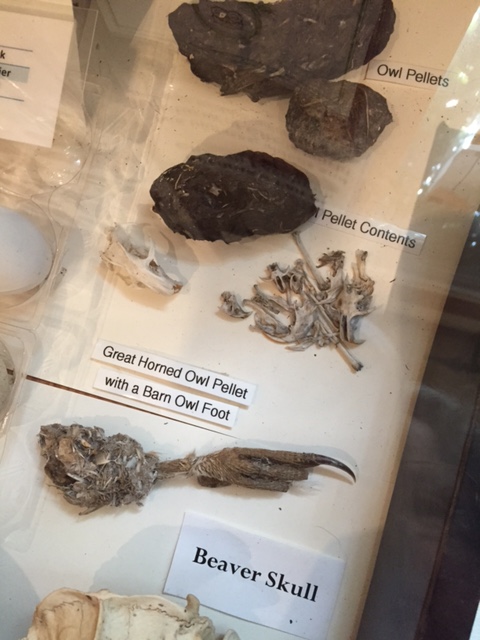
Copyright Louise Shimmel – Used by permission
Addendum #2 – Good friend Mike Shaw of Hawkwatch International just sent me this photo of young Barn Owls that illustrates part of what he found and described in his amazing comment, below. He also sent me an image of one of the Great Horned Owl fledglings in the haystack but I’ve been having trouble retrieving that one for some reason. If and when I succeed I’ll add that one too.
Thanks Mike!
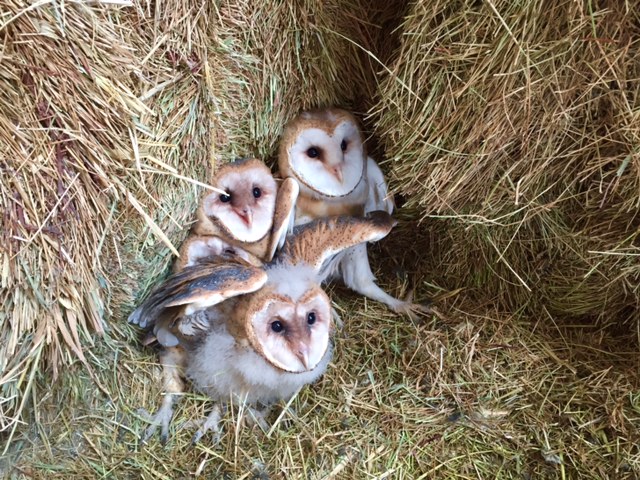 Copyright Mike Shaw – Used by permission
Copyright Mike Shaw – Used by permission
Ok, Mike sent me another version of the Great Horned Owl fledgling in the haystack.
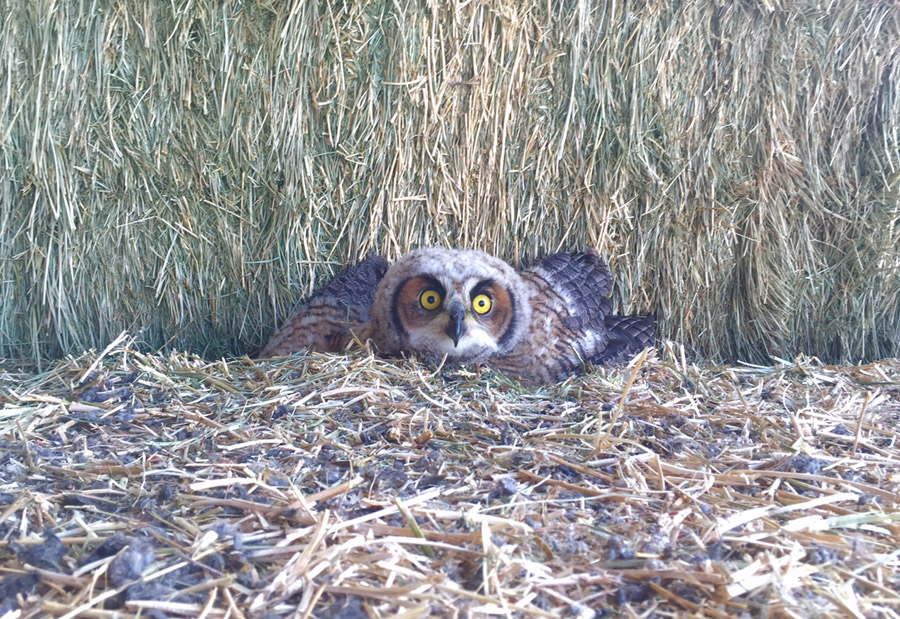 Copyright Mike Shaw – Used by permission
Copyright Mike Shaw – Used by permission


It is well known in our area that the GHO is very territorial and that Barn Owls are prey to them, so this is an amazing story in many ways. I will
assume that since their preferred prey is so plentiful they don’t go after the Barn Owl chick or even the parents. I do believe that they will avoid
preying on anything that is capable of injuring them unless they are very hungry. They seem to instinctually to know that if they are injured they won’t survive because they can’t hunt. Nature never ceases to amaze me and I do so wish we had areas where food was so plentiful that all could live peacefully in proximity of each other. This is really wonderful … so does the hay stay so the birds can survive … and then what about the livestock 🙂 A conundrum for sure.
Dick Harlow makes a very good point about imprinted behaviour. It re=enforces what I’ve long thought about captive bred and released birds falling prey to others.
While I’ve never noted bigger owls, like Ninox strenua, preying on smaller ones, my experience was limited to rehab and to the local wildlife in my personal area.But we certainly had good numbers of Barn owls, Ninox nova zealandia, N. strenua and N. connivens all hunting/nesting across several 10 acre properties
Thanks for all the wonderful pictures.
Great photos and wonderful stories about these owls. I love Mike’s description of the “owl high-rise apartment building.” Just hope the landlord can hold off on moving the remaining hay bales til all the babies (including ducks) have been able to fledge! Surely the birds wouldn’t all break their leases and move into the nest boxes before then??
Oops – Also meant to tell you the owls photos are just magnificent – what gorgeous raptors!! I’m like Debbie & have seen many Owls & other raptors but only as non-releasable birds. Waiting for my chance to see them in the wild!!
Fascinating, Ron! I love owls and always want to know more. I have never seen a live non-captive Barn Owl. I hope to see one someday.
For many years until 2013, we had both Eastern Screech Owls and GHOs in our urban neighborhood in Houston. The GHOs follow the ESOs as a food source – I was told by a local naturalist.
I love your blog.
Debbie
For the last 3 years there have been barn owls with 3 fledgings in a really unusual place. They don’t coexist with Great Horneds, but they coexist with vehicles both commercial and passenger, as well as hundreds of other bird visitors (and my camera) It is a local big box store, but I don’t want to publically say which one while there is the possibility of babies. They must have started early in January and have already fledged three. Is it possible for another group from the same parents this year? They are so amazingly fearless. I would be happy to tell you where they nest and you can decide what is appropriate.I have several “Not Dudley worthy” photos I could send you.
Susan, it isn’t uncommon for Barn Owls to raise a second brood in a season in Utah. And sure, I’d like to see your photos. I’ll send you an email so you have my email address. It’s nice to hear so many stories of Barn Owls nesting successfully this year, especially after two winters ago when so many of them died in the cold.
Fantastic series. Makes me want to spend time poking around inside barns for some reason…
I know the feeling, Dan…
Hi Ron, your post is very timely and coincidental. There’s a hay shed about the same size as the one you reference on the mainland across from the southern tip of Antelope Island. A Great horned owl has nested there about 9’ off the ground on top of a bale of hay for the last few years. She’s very visible on the outer row of bales and the ranch hands defer to her by leaving that stack alone when it comes time to load hay for their outlying herd. They use the big 3 string bales that can only be moved by forklift, and she never seems to blink despite being in the middle of all the commotion. This year they noticed an occasional dead Barn owl chick appearing on the ground in the same spots where bales were pulled. It looked as though a Barn owl had tunneled between the seams of the bales and established a hidden nest. All good until the force of moving the 1000+ pound bales killed the unseen chicks. This particular ranch hosts a number of kestrel boxes and is very pro raptor/wildlife, so they called for help to find a solution. The shed was about 1/2 full of hay about 2 weeks ago when I was able to get out there with a ladder, climb on the top of the 20’ stack, and look into all the seams. Holy %$#&! Ten to twelve, maybe more, Barn owls flushed out from the bales in every direction! There wasn’t one nest in the stack- there were multiples! I was able to count 7 active nests, either eggs or chicks, and am quite sure there were more out of sight in the system of tunnels the owls had hollowed out between the various levels of bales. It was like an owl high rise apartment building. Two nests were only a yard apart in the same seam- one on eggs and the other on chicks. A very cozy and tolerant relationship! The kicker was finding a female mallard sitting on 5 eggs, right ABOVE the horned owl nest and about 4’ directly BELOW where the male horned owl perches, and literally in the middle of all the Barn owls! (Sorry for so many exclamation marks, but it was crazy!! Lol.) I dissected pellets from the horned owl bale and only found what looked to be mammal bones. It appears that all the various nesters have worked out an arrangement in an area that offers an over abundance of prey and a dearth of nesting sites… and it seems to be working. Well, the mallard might not agree… 😉 I think Dick Harlow’s comment applies here.
Nest boxes went up yesterday. We initially hoped to get both owl species up and out of the hay by installing a box at each end, similar to the AI shed, but ended up staggering eight throughout the rafters after realizing the extent of the nesting population. It will be interesting to see what happens. A final curiosity: while moving stuff around yesterday to access the rafters I kicked aside an old tarp on the ground in a corner formed by 2 bales… only to find another nest of 4 ready to fledge Barn owls!
How absolutely incredible. Jealous thoughts here. Rather a lot of them. I could feel my eyes turning green as I read this comment, and I am pretty certain they are now glowing.
Holy Moly Mike, what an incredible story and situation. And thanks for permission to post the photos you just sent me, which I’ll do now.
After that, I’ll be reading your comment again just to digest it all better. I’m literally blown away by what you found in that haystack!
What a thrilling blog, Ron & Mike’s post was unbelievable & exciting to have such a safe haven for SO many nests of different owls. I side with Dick and feel that there are two reasons for these two types of owls to tolerate each other. Definitely abundance of food but also the many seasons of nesting & the young ones fledging so close to each other – almost raised together. Thanks to FaceBook I’ve seen amazing videos of various animals cohabitating that should be -if not enemies – a food source out in their wildlife areas. So, often it’s that they were raised together & didn’t have to hunt for food. The one example that comes to mind is a bear, tiger & lion cubs that grew up together & are now adults & play & sleep together. Makes you think that this is what the Garden of Eden must have been like – LOL!!
Amazing. And “wonder-full”.
Had to read it several times. Thanks for sharing!
“Wonder-full” indeed!
P.S. And wonderful photography Neil Rossmiller!
Fantastic!!! Never heard of anything like it…….
Wow, Mike! That’s an incredible find. We have had good luck moving youngsters from inappropriate nesting sites to boxes – e.g., from behind torn insulation in the rafters of a barn at the county fair grounds; eggs can be tougher, since obviously they don’t vocalize to call the parents, but if you can lock the female into the box with the eggs for a while, she may ultimately settle down on them, getting over the stress – then pull the covering off the opening. I always feel so bad disrupting those nests between hay bales, as they are such a perfect place from the birds’ point of view! Last year, one mama owl wouldn’t leave the nest so we took her, too, and let her raise them (plus a few extra we contributed – grin) at our facility and then released her back out where we got her. A colleague in Pendleton OR has a satellite facility near the twin cities just over the border in WA – and they have established an amazing hack site for youngsters (and they got over 400 barn owl orphans last year). Nesting naturally at the site are long-eared owls and barn owls, and maybe even great horneds and, I think, Swainson’s hawks – they put the orphans into the hack boxes as soon as they can pick up food and thermoregulate – and the wild birds often add food! In her newsletter today, she has photos of some of this year’s barn owls fledging from a box while a clutch of wild brancher long-eared owls look on. I worry about concentrating so many releases there, but there are thousands of appropriate acres of habitat around and it has worked so far.
Hi Louise, we initially thought there was only one Barn owl nest in the stack and planned to relocate it into a box as you suggested. After finding so many different clutches of eggs and chicks, some accessible, some not, we elected to leave everything as is. Now that the rancher knows the extent of the population he’s going to pull bales from another barn until this tribe finishes it’s nesting cycle. He’s more than willing to trade the inconvenience for the pest control being done in the surrounding alfalfa by the “night shift” workers. (btw- the amount of pellets is staggering) It might take a couple of nesting cycles before most or all of the birds move into the boxes, but hopefully they figure out it’s ultimately a safer place to be. I was musing to Ron about the possibility of the habituated hay nesters staying put while a whole new population of box nesters shows up and effectively doubles the nest count! Nah, inconceivable… Lol.
One thing is for sure they sure are fine looking families! Great shots Ron!
I’m glad you like them, Nancy. Thanks.
Great Horned, Barred, Saw-wet, Screech and Short-eared Owls are in our neck of the woods. It has been my observation that Great Horned Owls are the King in our area. If food is plentiful, or easy to come by I have seen Barred Owls fairly near Great Horned, but that is not usual. It has been my experience that if you hear a Great Horned, Barred Owls will be long gone. However, I have heard Screech and Barred, and Screech and Great Horned calling fairly near each other. I suspect if food is plentiful competitors will be more tolerant. If food is scarce I think you will find the literature will be more accurate than not. It is all a matter of survival! Yet I tend to believe that predator individuals have personalities, and if they were brought up under circumstances where they are in close proximity to another predator species and seemed to coexist, that imprint would stay with the young and could result in a recurrence of that type of behavior.
Just my 2 cents.
“if they were brought up under circumstances where they are in close proximity to another predator species and seemed to coexist, that imprint would stay with the young and could result in a recurrence of that type of behavior”
Very good point, Dick.
I can add nothing but my thanks. To you, and to your knowledgeable commentators. Many, many thanks.
And of course thanks go to the owls as well.
Thanks very much, EC.
In our nature center, we have a great horned owl pellet that includes a barn owl foot and part of the leg – found in a barn out near the west Eugene wetlands – besides proof that great horneds will eat fellow owls (which I never doubted), it looks like it would have been very uncomfortable both going down and coming back up! Ron – I’ve sent you a photo to your email address; share it here if you think it would be of interest. In terms of the specific question you pose, I confess I lean towards the theory that the great horneds tolerate the barn owls as a potential food source and perhaps because they don’t have to compete for food, given the great horneds wider choices of prey. I can only hope that the barn owl parents can teach their young to not trust their neighbors – which is one of the primary concerns I always have as a rehabilitator releasing naive barn owls – we get a fair number every year, since they choose some foolish places to nest. Here in Oregon, great horneds are pretty much everywhere.
I always appreciate your knowledgeable input Louise and this time is no exception. But you’ve outdone yourself with this photo of the Great Horned Owl pellet with a Barn Owl leg. Thanks very much!
Louise – I’m not surprised about the barn owl foot & part of the foot in the GHO’s pellet. I’ve been watching the Berry College Bald Eagle nest in Rome, Ga for 2 seasons. During the winter months when the fish go deeper in the surrounding lakes, the Parents main source of food is the large population of coots on the lakes. They actually seem to relish the coot feet. It would be interesting to see their pellets to see how much of the coot feet show up in them!!
Eagles and other diurnal raptors have a more acidic stomach then owls, apparently, and they crunch and crack up their food more than owls do (though I’ve seen some whole prey items go down, especially with ferruginous hawks) – so you see fewer of the small bones in their pellets. But those coot feet are nice and fleshy – nom nom!
Hi Ron,
I wonder if there aren’t some factors unique to Antelope Island SP, Lava Beds NP that Dick mentions and other locals that preclude “Normal” behavior. Ease of prey, nesting site availability or negotiated peace agreements that they fall out of the normal range because to much energy would otherwise be spent. Very interesting on many levels.
I’m currently observing and documenting the first ever reported Long-eared Owls in Summit county. Our current infestation of voles (third year) has overpowered the adults fear of being in close proximity to humans or so it would appear. I never know where they might be until it’s too late to avoid disturbing them short of locking myself in the house for several more months. They moved into the neighborhood last November/ December and have successfully nested this spring. Hawkwatch Intl is documenting the event as well. The fledges reaction to any raptor overhead would certainly indicate that that would be where their major threat would come from. The fledges tolerate my presence to a small degree, but the Adults depart long before I get anywhere close. I would conclude that ease of prey trumps other behavioral tendencies. No need to pick a fight if one is sated with nourishment.
Neil
P.S. some images in my owl gallery
“No need to pick a fight if one is sated with nourishment”
Maybe that’s it, Neil.
Wow, that’s so neat about the Long-eared Owls so close to you. And you make a good point about their major threat likely coming from above.
Readers can see some of Neil’s Long-eared Owls here if you’re interested: http://www.rossmillerphoto.com/album.php?albid=18
OR…”You can be nice when your’e full of mice”
Hi Ron,
The Petroglyphs unit of Lava Beds National Monument (far northern CA) is a very well-known spot where both species have nested very close to each other for years. The nest sites are in crevices and on ledges of a relatively low cliff face. This year, I was able to observe each of these species as I stood in one location in the parking lot. Three or four years ago, one could observe both owls’ sites in the same binocular field of view. The first time I saw this, I wondered about what would happen to the Barn Owls, but it seems to have worked so far. Maybe they pay “protection”? Or maybe I’ve seen too many old gangster movies…
Cheers,
Dick
Now that’s very interesting, Dick. How close would you say those nests are to each other? I’d estimate that these two nest boxes are approximately 40′ apart.
Have you seen aggressive behavior between the owls at your two nests?
Hi Ron,
The two sites were perhaps 75-100 yards apart, but within sight of one another. I have not returned to see if there are Barn Owl young. 3-4 years ago, the two nests were within 60 feet of one another, and I did observe Barn Owl babies. Here’s a thought that just popped up – the Great Horned’s might be raising their own food supply…! 🙂
On the other hand, your posting reminded me of frequent reports of Great Horned Owl – Barn Owl predation at a place known as “owl woods” in outer Point Reyes, CA, where I used to bird frequently. In those instances, the Great Horned’s were nesters and the Barn Owls were passing through (or attempting to). Finally, the Carneros winegrape growing district in CA has a LARGE number of Barn Owls that nest in boxes erected by growers. Great Horned’s are believed to predate them on a regular basis.
Bottom line: I have always shared your belief that Great Horned’s would not tolerate other owls nearby. The Petroglyph birds and the Antelope Island birds remind me of the old adage: “Never say never”.
Cheers,
Dick
Thanks for answering my questions, Dick.
And you’re certainly right about “never say never”…
On a related note, we are watching a traditional Peregrine eyrie. This eyrie has 3 GHOW chicks, and a very protective mother. Because of the early nesting of GHOW, we have not seen any PEFA nesting activity…
Interesting, DBW. Obviously they call the GHO the “Tiger of the Sky” for very good reason.
I find myself wondering if these Owls are tolerating each other because that is the only place on the island that is suitable for nesting? Whatever the reason, I’m glad they’re defying the apparent norm.
Susan, It’s true that there aren’t many trees or buildings on the island that are suitable for nesting owls but I’m not sure that would make them more tolerant of each other. Seems to me that it might have the opposite effect but what do I know…
Very interesting…and very surprising, but then, in spite of their wise appearance, owls don’t read, at least mine didn’t,and therefore don’t know the rules. Since most wildlife survival boils down to food-finding, Arwen’s theory sounds right on –both abundance of food and the treaty. (She sounds pretty “wise” herself)…… Wonderful images. Love the baby GHO’s peeking put of the box. They look about the same age mine was when I got him–and the Barn owls look so beautiful and sleek. They always look like they’re sprinkled with stardust…….
“They always look like they’re sprinkled with stardust”
Yes, they certainly do, Patty – especially their backs.
The food availability theory could be part of it but if so I’m surprised that BNA didn’t mention it. They’re usually pretty thorough when explaining behaviors like this but they simply said that GHO’s “rarely” tolerate other owls.
Very interesting. I wonder if it is because of an abundance of prey. No need to defend territory maybe?
Or maybe it’s due to the Great Owl Treaty of ’89? 🙂
I suppose that abundance of prey could be at least part of the equation, Arwen.
Arwen-I’m sure you’re aware that that the Great Horned Owl Treaty of ’89 is sometimes referred to as “G.O.T.” (or “GOT”) and is based on “got food” much like the dairy slogan “got milk”….,,
Actually, that’s the Great OWL TREATY, jot great HORNED owl treaty of ’89
Well it was the Great Horneds who initiated it. It is hard to not call it G.H.O.T. ;D Thanks for the chuckle this morning.
Astonishing! YES! I have watched a tree hole occupied by barn owls for some years… and have seen the Great Horn Owls torment them for being too close to their chosen nest.
Again… thank you for sharing your photos with us.
CJ
Thank you, CJ! That’s exactly the kind of feedback that I am particularly interested in.
Interesting that I have never noticed any aggression or even tension between these owls.